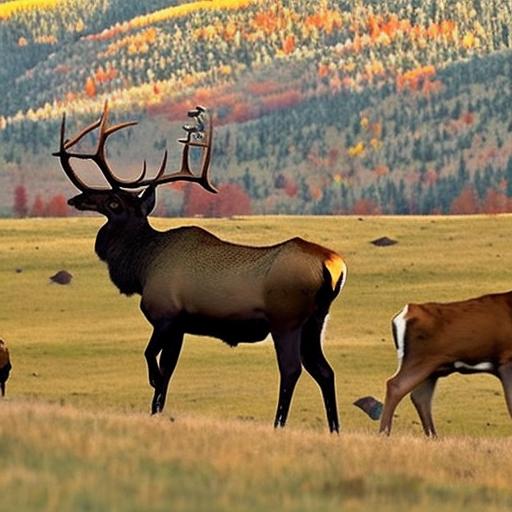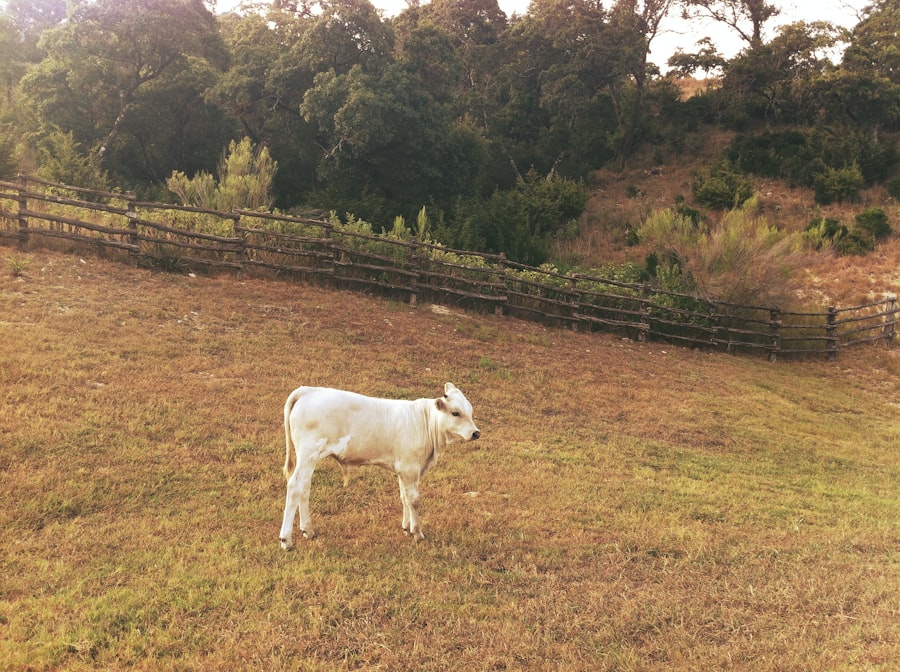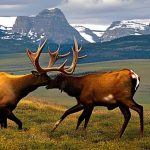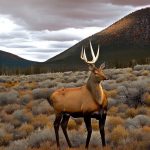Your cart is currently empty!

Unleashing the Thrill of Cow Elk Hunting: A Guide to a Successful Hunt

Cow elk hunting is a popular and challenging pursuit for many hunters. While bull elk hunting often gets the spotlight, cow elk hunting offers its own unique set of rewards and challenges. Understanding the behavior and habits of cow elk is crucial for a successful hunt. By studying their social structure, feeding and bedding habits, and seasonal behavior patterns, hunters can increase their chances of a successful harvest.
Key Takeaways
- Cow elk are social animals that travel in herds and have specific behaviors and habits that hunters should understand.
- Choosing the right hunting gear and equipment, such as a quality rifle and binoculars, is crucial for a successful cow elk hunt.
- Scouting techniques, such as looking for fresh tracks and droppings, can help hunters locate cow elk in their natural habitat.
- Planning ahead, including scouting the area and understanding the terrain, can increase the chances of a successful cow elk hunt.
- Tracking and stalking cow elk requires patience, stealth, and knowledge of their behavior and habitat.
Understanding the Behavior and Habits of Cow Elk
Cow elk live in social groups known as herds. These herds are typically led by a dominant cow, known as the matriarch, who makes decisions about where to feed and bed. Understanding the social structure of cow elk can help hunters anticipate their movements and behavior. It is important to note that cow elk are highly adaptable and can change their behavior based on environmental factors such as weather and hunting pressure.
Feeding and bedding habits are also important to understand when hunting cow elk. Cow elk are herbivores and primarily feed on grasses, shrubs, and other vegetation. They tend to feed in the early morning and late afternoon, spending the rest of the day resting and ruminating. Knowing where cow elk like to feed and bed can help hunters locate them more easily.
Seasonal behavior patterns also play a role in cow elk hunting. During the summer months, cow elk tend to stay at higher elevations where there is ample food and cooler temperatures. As the weather cools down in the fall, they begin to migrate to lower elevations in search of better forage. Understanding these seasonal movements can help hunters plan their hunts accordingly.
Choosing the Right Hunting Gear and Equipment
Having the right gear and equipment is essential for a successful cow elk hunt. Clothing and footwear should be chosen based on the weather conditions and terrain of the hunting area. Layering clothing is recommended to regulate body temperature during varying weather conditions. Sturdy boots with good ankle support are necessary for navigating rough and uneven terrain.
When it comes to firearms and ammunition, hunters should choose a rifle and caliber that they are comfortable and proficient with. A rifle chambered in a caliber suitable for elk, such as .270 Winchester or .30-06 Springfield, is recommended. It is important to practice shooting at various distances to ensure accuracy and confidence in shot placement. Additionally, hunters should carry enough ammunition for multiple shots if needed.
Optics and accessories such as binoculars, spotting scopes, and rangefinders are also important tools for cow elk hunting. Binoculars help hunters spot elk from a distance, while spotting scopes allow for closer examination of potential targets. Rangefinders help determine the distance to the target, ensuring accurate shot placement.
Scouting Techniques for Finding Cow Elk
| Scouting Techniques for Finding Cow Elk | Description |
|---|---|
| Glassing | Using binoculars or spotting scopes to scan the landscape for elk. |
| Tracking | Following elk tracks and droppings to locate their feeding and bedding areas. |
| Calls | Using cow elk calls to attract and locate cow elk. |
| Water Sources | Locating water sources and monitoring them for elk activity. |
| Food Sources | Identifying preferred food sources of elk and scouting those areas. |
Scouting is a crucial step in preparing for a cow elk hunt. Identifying elk habitat is the first step in finding cow elk. They prefer areas with a mix of open meadows, dense forests, and water sources. Look for signs of elk activity such as tracks, droppings, rubs on trees, and wallows.
Locating feeding and bedding areas is key to finding cow elk. They tend to feed in open meadows or grassy areas early in the morning and late in the afternoon. Bedding areas are usually located in dense forests or thick brush where they can find cover and protection from predators.
Using trail cameras and other scouting tools can also be helpful in locating cow elk. Trail cameras can be set up near feeding or bedding areas to capture images of elk movement. This can provide valuable information about the size of the herd, their behavior patterns, and the best times to hunt.
Planning a Successful Cow Elk Hunt
Planning is essential for a successful cow elk hunt. Choosing a hunting location should be based on factors such as accessibility, elk population density, and hunting pressure. Researching public land hunting opportunities and talking to local wildlife agencies can provide valuable information about potential hunting areas.
Obtaining necessary permits and licenses is also important. Each state has its own regulations and requirements for elk hunting, so it is crucial to familiarize yourself with the specific rules and regulations of the area you plan to hunt in. Applying for tags and permits well in advance is recommended, as they are often limited and in high demand.
Planning for transportation and accommodations is another important aspect of a successful cow elk hunt. Determine how you will get to the hunting area and whether you will need to rent a vehicle or use a guide service. Additionally, consider where you will stay during the hunt, whether it be a hotel, campground, or backcountry campsite.
Tracking and Stalking Cow Elk in the Wild

Tracking and stalking cow elk in the wild requires patience, skill, and knowledge of their behavior. Reading elk sign, such as tracks, droppings, and rubs, can help hunters determine the direction of travel and proximity of elk. Fresh sign indicates recent activity, increasing the chances of encountering elk.
Approaching elk without being detected is crucial for a successful stalk. Using natural cover such as trees, rocks, or terrain features can help conceal your movement. Move slowly and quietly, paying attention to wind direction to avoid being detected by their keen sense of smell.
Using calls and decoys can also be effective in attracting cow elk. Cow calls imitate the sounds made by female elk and can be used to lure them closer. Decoys can be set up to create a visual attraction for curious elk. It is important to practice using calls and decoys before the hunt to ensure proper technique.
Shooting and Hunting Techniques for Cow Elk
Shot placement is crucial when hunting cow elk. The vitals of an elk are located behind the shoulder, slightly above the center of the chest. A well-placed shot in this area will result in a quick and ethical kill. It is important to practice shooting from various positions and distances to ensure accuracy and confidence in shot placement.
Judging distance and wind is also important when hunting cow elk. Rangefinders can help determine the distance to the target, allowing for more accurate shot placement. Wind can affect bullet trajectory, so it is important to consider wind direction and speed when taking a shot.
Hunting in groups or solo is a personal preference. Hunting in a group can provide safety and camaraderie, as well as the ability to cover more ground. However, it can also increase the chances of spooking elk due to increased noise and movement. Hunting solo allows for more stealth and flexibility, but requires self-reliance and careful planning.
Field Dressing and Processing Your Cow Elk
Proper field dressing techniques are essential for preserving the quality of the meat. Start by making an incision from the base of the sternum to the anus, being careful not to puncture any organs. Remove the internal organs, being mindful of any potential contamination. Cooling the meat as quickly as possible is crucial to prevent spoilage.
Transporting and storing meat should be done in a way that maintains its freshness and quality. If possible, quarter the elk in the field to make it easier to transport. Use game bags or coolers with ice packs to keep the meat cool during transportation. Once home, properly package and store the meat in a freezer or refrigerator.
Preparing and cooking elk meat requires special attention to ensure tenderness and flavor. Elk meat is leaner than beef, so it is important not to overcook it. Marinating or brining the meat can help tenderize it and enhance its flavor. Cooking methods such as grilling, roasting, or slow cooking can bring out the best in elk meat.
Safety Tips for Cow Elk Hunting
Safety should always be a top priority when hunting cow elk. Familiarize yourself with firearms safety rules and always treat your firearm as if it is loaded. Keep the muzzle pointed in a safe direction and only place your finger on the trigger when ready to shoot. Be aware of your surroundings and never shoot at a target you cannot positively identify.
Avoiding dangerous wildlife is also important when hunting cow elk. Be aware of the presence of other large predators such as bears or mountain lions in the area. Carry bear spray or other deterrents if necessary. Additionally, be cautious of other hunters in the area and always wear blaze orange to increase visibility.
Navigating rough terrain can present its own set of challenges and safety risks. Always wear appropriate footwear with good traction to prevent slips and falls. Use trekking poles or walking sticks for stability and balance. Take breaks as needed and stay hydrated to prevent fatigue and dehydration.
Strategies for Hunting Cow Elk in Different Seasons
Hunting cow elk in different seasons requires different strategies due to their changing behavior patterns. Early season hunting, typically in late summer or early fall, requires locating feeding areas where cow elk are likely to be found. Focus on areas with abundant food sources such as meadows or grassy slopes.
Late season hunting, usually in late fall or early winter, requires locating bedding areas where cow elk seek shelter from harsh weather conditions. Look for areas with dense forests or thick brush where they can find cover and protection. Pay attention to weather patterns and adjust your hunting strategy accordingly.
Hunting during the rut, which typically occurs in the fall, can be an exciting time to hunt cow elk. During this time, cow elk are more vocal and active as they seek out mates. Using cow calls or bugles can attract bull elk, which in turn may draw in cow elk. Pay attention to their behavior and use their increased activity to your advantage.
Conservation and Ethical Considerations in Cow Elk Hunting
Conservation efforts play a crucial role in maintaining healthy elk populations and preserving their habitat. Hunters should support organizations and initiatives that promote conservation and habitat restoration. Additionally, practicing ethical hunting practices such as fair chase, respecting bag limits, and properly disposing of waste is important for the sustainability of elk populations.
Respect for wildlife and the environment should always be a priority when hunting cow elk. Leave no trace by packing out all trash and minimizing your impact on the environment. Treat the animals with respect and gratitude for providing sustenance. Take only what you need and use all parts of the animal to honor its life.
Cow elk hunting offers a unique and rewarding experience for hunters. Understanding the behavior and habits of cow elk is crucial for a successful hunt. By studying their social structure, feeding and bedding habits, and seasonal behavior patterns, hunters can increase their chances of a successful harvest. Choosing the right gear and equipment, scouting techniques, planning, tracking and stalking techniques, shooting and hunting techniques, field dressing and processing, safety tips, strategies for different seasons, conservation and ethical considerations are all important aspects to consider when embarking on a cow elk hunt. By approaching cow elk hunting responsibly and ethically, hunters can enjoy this challenging pursuit while also contributing to the conservation of elk populations and their habitat.
If you’re interested in cow elk hunting, you might also enjoy reading our article on “How to Hunt Grouse Without a Dog.” Grouse hunting can be a thrilling and challenging experience, and this article provides valuable tips and techniques for hunters who prefer to hunt without the assistance of a dog. Whether you’re a beginner or an experienced hunter, this article will help you improve your grouse hunting skills. Check it out here.
FAQs
What is cow elk hunting?
Cow elk hunting is the act of hunting female elk for their meat and other resources.
When is cow elk hunting season?
The cow elk hunting season varies by state and region, but typically takes place in the fall and winter months.
What equipment do I need for cow elk hunting?
Some essential equipment for cow elk hunting includes a hunting rifle, ammunition, hunting boots, warm clothing, binoculars, and a hunting license.
Do I need a license to hunt cow elk?
Yes, a hunting license is required to hunt cow elk. The specific requirements and regulations vary by state and region.
What is the best way to hunt cow elk?
The best way to hunt cow elk is to scout the area beforehand, locate the herd, and then approach quietly and carefully. It is important to take a clean shot to ensure a humane kill.
What should I do with the meat after a successful cow elk hunt?
After a successful cow elk hunt, the meat should be properly processed and stored. It can be used for a variety of dishes, such as steaks, roasts, and ground meat.

Herb has been a longtime lover of the outdoors. Whether it be hunting, camping, fishing or just getting outside to reset. Proud father and animal lover. Bourbon anyone?

by
Tags:
Comments

Categories
- Big Game Hunting (301)
- Deer (202)
- Reviews (3)
- Shooting (16)
- Slingshot (1)
- Small Game Hunting (42)
- Upland Hunting (126)
- Waterfowl Hunting (3)





Leave a Reply